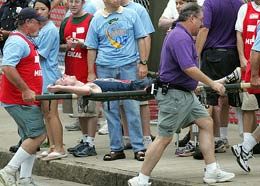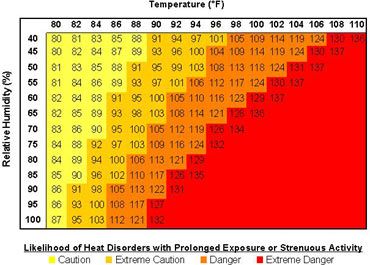 AP Photo/Ric Feld An exhausted runner is carried from the course after finishing the Peachtree Road Race in Atlanta, 2005. |
Every year on the Fourth of July, a group of about 55,000 people — aged from eight to 80 — run a 10-kilometer race through the city of Atlanta. Some are world-class athletes who complete the race in about 30 minutes, while others are “less-conditioned” individuals who want the novelty of being part of the big event.
The temperature is typically above 72 F and by the end of the race about 200 people are normally ill. A group of trained observers watch the competitors as they reach the finish line, and pull out the runners that need medical attention, administering rapid cooling. On average, one runner per year is too ill to recover on the scene, and receives aggressive care at a hospital for heat stroke. There are actually things that we can learn from this annual race.
Heat can kill across the spectrum of ages and physical conditions. Innovative research carried out at the University of Delaware has identified the early months of summer as the peak time for heat-related deaths, particularly if hot temperatures arrive earlier than usual. By August and September, Americans are acclimated to heat, and death rates from heat-related causes fall.
Before we close the book on the very hot summer that we have endured in 2007, we should update our plans for managing heat-related issues for the fire service for 2008. One important element of that is a fire rehabilitation plan for hot weather conditions.
A tool developed by the National Weather Service can assist in setting parameters for fire rehab planning. This Heat Index Chart combines the effect of temperature and humidity to define times when conditions for humans will be dangerous. The combination of temperatures above 80 F and humidity above 40 percent can lead to progressive degrees of heat stress and danger. The National Weather Service categorizes the likelihood of heat disorders by the terms:
- Caution (heat index more than 80)
- Extreme Caution (heat index more than 91)
- Danger (heat index more than 105)
- Extreme Danger (heat index more than 125)
 NOAA’s National Weather Service’s Heat Index Chart |
For those without a plan already, it can be beneficial for fire service leaders to develop procedures for the 2008 “heat season” that are based on these categories of danger for rescue workers. The fire rehab process can be built around the categories, and in most cases a daily or weekly plan for implementation can be put into place based on the forecast.
The Heat Index Chart measures the effects of heat plus humidity. It’s important to note that the heat index is calculated for shady, light wind conditions; heat exposure will of course worsen for those exposed to full sunshine, or when hot, dry winds are present.
As mentioned earlier, people are more susceptible to heat-related problems before summer truly begins as they’ve had little chance to acclimate to warm weather. Because of this, fire service heat plans should target the spring months.
People release heat from the body through blood circulation, by losing water through the skin and sweat glands, and, like our dog friends, by panting. As heat conditions build, by exposure or by exercise, the heart pumps more blood, the blood vessels dilate to accommodate increased flow, and many tiny capillaries in superficial skin layers are put into operation. Incidentally, alcohol has the same effect, and is a good reason why young men with a little extra alcohol aboard will appear bare-chested at football games in icy conditions.
Diffuses through skin
With blood circulating closer to the skin’s surface, water diffuses through the skin as perspiration, and even more heat drains off into the cooler atmosphere. With this combination of mechanisms, the skin handles about 90 percent of the body’s heat dissipating function. High humidity reduces the effectiveness of the heat loss process. Sweating is only effective if the water is removed by evaporation, but high relative humidity retards evaporation. Under low humidity conditions, the heat energy required to evaporate the sweat is extracted from the body, thereby cooling it.
But when temperatures are above 90 F and high relative humidity present, the process cannot work. Cooling only occurs in these situations if the hot, sweaty body can be ventilated with a cool, dry breeze. Heat disorders occur when the individual has overexposed or over-exercised for his age and physical condition in the existing thermal environment. This particularly occurs when the body is not acclimated to the conditions.
Acclimatization has to do with adjusting sweat-salt concentrations, which becomes more efficient as the summer season progresses, among other things. Heat disorders generally result from the collapse of the body’s ability to shed heat by circulatory changes and sweating. In most people, the heat-exposed patient is not dramatically dehydrated and most people can compensate for fluids and salt lost through perspiration. Heat problems are not solved by intravenous fluids and electrolytes.
What can we learn about heat emergencies from the Peachtree Road Race in Atlanta? For starters, the observers have to look for warning signs, racers that are pale, confused and clumsy. They can have a faraway look in their eyes and are liable to collapse. Heat stress in these situations is treated by rapid cooling, not by intravenous fluids. Oral fluids must be administered small amounts at a time, or the victim will vomit.
Heat stroke is defined by altered mental status, typically by a state of confusion or combativeness, pale skin, inability to tolerate oral fluids, and no response in five to 10 minutes of aggressive cooling. It’s important to remember that an altered mental status is a warning sign of life-threatening heat illness. High heat index conditions create some of the most dangerous firefighting conditions.
For the preparation of a fire rehab program in hot weather for 2008, consider a modular approach to the process, depending on the forecast temperature and humidity. No doubt many departments will modify this as the season moves from spring to summer. Particularly in the southern service areas, the extra measures in the “caution category” can be downgraded in the months of July and August. Appropriate to the scene, the Rehab sector will include these elements and their modification as the heat index increases
• Shelter to include seating
• Fluid and Calories
• Equipment rehabilitation
• Health evaluation and therapy
• Cooling equipment
| Heat Index Category |
Caution
Extreme Caution
Danger
Extreme Danger
Predicted or Actual Heat Index
Over 80
Over 91
Over 104
Over 125
Implement if Planned Operation Time is:
Over 90 minutes
Over 60 minutes
Over 60 minutes
Over 30 minutes
Shelter to include seating
Shade preferred
Sun Shield
Sun Shield
Sun Shield, wind protection if windy conditions
Fluid and calories
Extra fluid encouraged, lukewarm or cool
Extra fluid encouraged, lukewarm or cool
Cool Fluids. Food may not be priority, if so fruits, starches
Cool Fluids, food discouraged
Equipment rehabilitation
Likely to become sweaty. Needs dried to prevent molding
Will be sweat-soaked
Will be sweat-soaked
Will be sweat-soaked
Health evaluation and therapy
Observe for signs of heat stress
Observe for signs of heat stress. Cool body with water over head, neck, wrists
Observe for signs of heat stress. Cool body with water over head, neck, wrists
Expect signs of heat stress. Cool body with water over head, neck, wrists
Mental decompression
Cool shaded area preferred
Cool shaded area preferred
Must be shaded
Must be shaded
Cooling equipment
Fans or cool misters optional. Typically less need for toileting
Fans or cool misters optional.
Fans or cool misters mandatory
Fans or cool misters mandatory
Good rehabilitation programs are a big step in preventing acute injuries and the fatigue or thirst that can cause judgment errors. They mean that you can manage the next incident safely, or go home to your family without being completely exhausted and even play a game of basketball with the kids.
Join me, and make your goal to be a healthy retiree.
| Discuss this article at FireRescue1 Forums |












